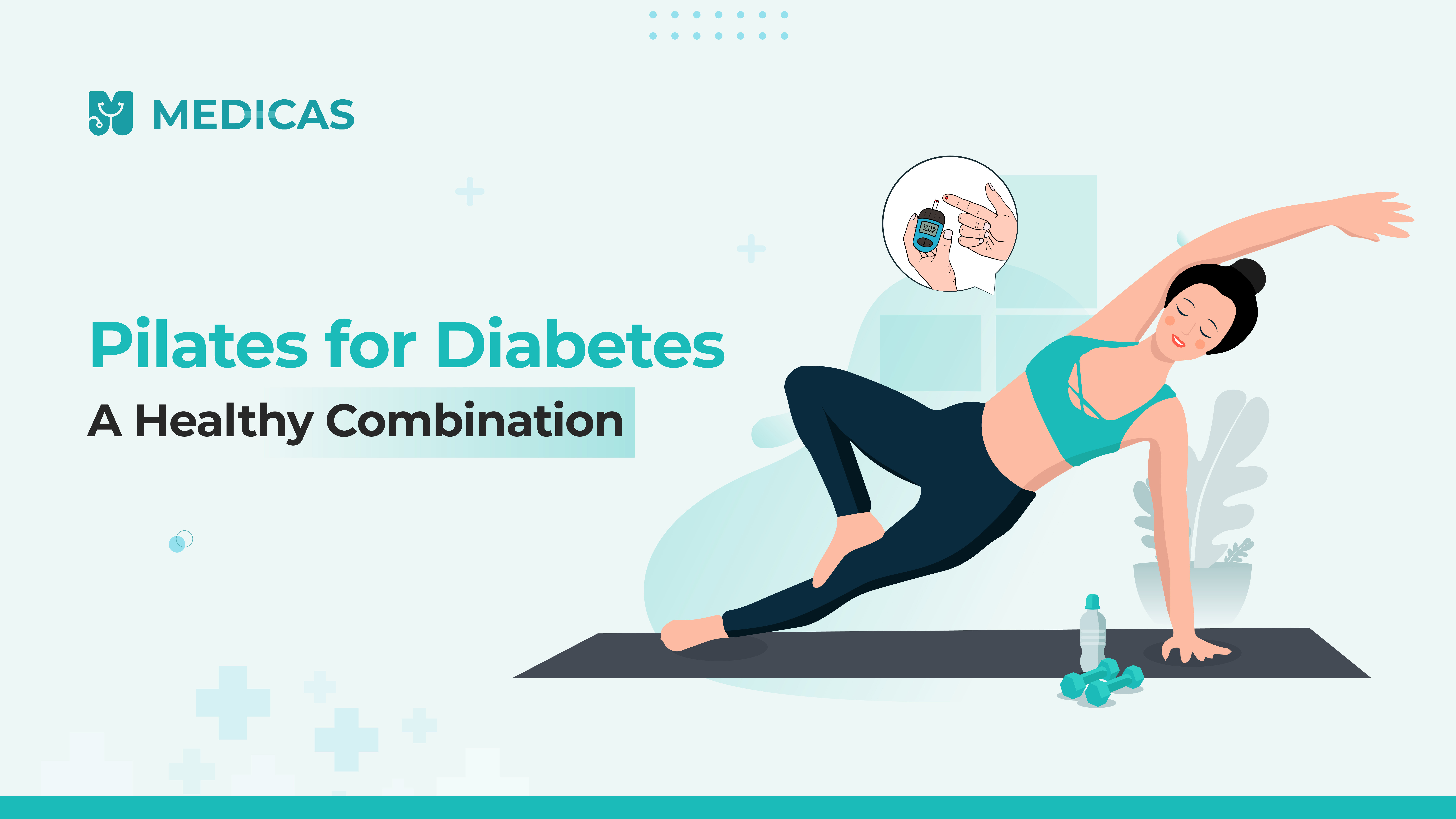Quick Links
With more than 100 million patients, India is rightly called the “diabetic capital of the world.” Often underestimated, diabetes is a chronic metabolic condition that brings significant challenges. While most diabetic people can avoid complications, there are many unhappy cases too. Some can’t help but live on a cocktail of medicines, have limited food choices, and stay unhappy.
While diabetic patients are advised to live an active lifestyle, some may find it difficult due to other underlying health issues. For those who do, they still aren’t sure about the best exercise for people with diabetes. That’s where Pilates comes in.
As a popular controlled-movement exercise, pilates has been researched over decades and is highly recommended for Type 2 diabetes. This article introduces you to pilates for diabetes, discusses the first-hand benefits, and offers vital tips for setting your own exercise routine. Keep scrolling!
Pilates and Diabetes Management-Getting the Basics Right
The role of exercise in reversing or putting diabetes into remission has been researched repeatedly. And most of the studies have come back with positive results, which means there’s no reason why you shouldn’t sweat it out.
Among other exercises for diabetes, pilates has been the centre of multiple medical studies showing impressive outcomes for diabetic patients. The reasons aren’t obscure.
- Pilates can be performed by anyone at any age.
- You don’t need any special equipment to perform pilates.
- A typical pilates session is no more than 20-30 minutes long and can be comfortably performed at home.
Tracing the efficacy of pilates for diabetes, a 2013 study showed improved parameters in women with type 2 diabetes. Another randomised control trial from 2021 showed Type 2 diabetic patients with reduced markers for glycated haemoglobin (HbA1c), ROS (Reactive oxygen species), and oxidative stress. Reportedly, the patients in the intervention group were put on a strict two-week pilates program, unlike the control group, which showed negative or no change in their vitals.
Although it doesn’t look like one, pilates is the simplest form of resistance training for diabetes patients. It promises near-zero injury, requires limited commitment, and can be performed anywhere, in your bedroom or lawn. There are two primary forms of Pilates to begin with:
- Mat-based Pilates comprises floor exercises and uses gravity and body weight to improve posture, coordination, and balance.
- Equipment-based Pilates works directly against spring-load resistance and includes the ‘reformer’ (a moveable carriage that pushes and pulls along a track).
First-hand benefits of Pilates for People with Diabetes
From lowering HbA1c values to offsetting cardiac problems, pilates packs a punch for people with diabetes. The American Diabetes Association recommends getting 150 minutes of moderate to intense activity. Pilates qualifies as a moderately intense workout, although it’s not every time you break into a sweat. With controlled and pre-planned movements, you are promised a slew of benefits.
- Improved Blood Glucose Level- Harvard Medical School notes that a variety of exercises for diabetes can reduce 0.7% of HbA1c across different ethnic groups diagnosed with diabetes. Pilates, in particular, has been found to dramatically lower postprandial and fasting blood glucose levels, as observed in an 8-week study of different ethnic groups with diabetes.
- Better Lipid Profile-Pilates reportedly lowered triglycerides, LDL, and total cholesterol in diabetic patients. This contradicts the almost negligible impact on HDL cholesterol observed in the same study.
- Reduced Body Fat Percentage cells are responsible for how our bodies utilise glucose to produce insulin. A higher body fat percentage means you are more prone to insulin resistance and closer to becoming diabetic. Reformer Pilates is proven to boost muscle mass and lower body fat percentage.
- Low impact on joints—Diabetic patients, especially overweight ones, are more prone to injury during a workout. Pilates attracts almost zero injuries, which makes it a less overwhelming option. It’s easy on joints, which helps a diabetic person achieve better body-movement coordination.
- Better state of mind- Anxiety, depression, and irritability are all telltale signs of diabetes. Practising pilates can boost serotonin production, uplifting one’s mood and keeping negative thoughts at bay.
How To Get Started With Pilates For Diabetes?
With diet restrictions and multiple medications, starting pilates can seem like a lot for a diabetic patient. However, by following simple steps, you should be able to incorporate a functional plan. Remember, pilates is like any other exercise (walking or running). So, your body will take some time to adapt to the new routine. Here are some practical tips to get going.
- Start slow and gradually increase the intensity.
- Choose and stick to one form of Floor or Reformer Pilates. For example, you can choose mountain climbers or leg presses.
- Aim to perform your pilates at least two to three hours after eating when your blood sugar levels are higher.
- For insulin users, testing your blood sugar levels before doing pilates is recommended if the test shows a blood sugar level below 100 mg/dL, munch on fruit or a snack to prevent hypoglycemia.
- For pilates for diabetes classes in a gym or under a personal instructor, tell them about your condition beforehand.
- Keep glucose candies handy just in case your blood sugar levels drop drastically.
Time to Add Pilates To Your Diabetes Management Plan
When it comes to choosing the best exercise for people with diabetes, pilates undoubtedly tops the list for more than one reason. It is recognized as a mainstream, moderately intense exercise with all-around benefits. It can also be performed safely at home or outside without supervision.
Besides controlling blood sugar levels, pilates can mitigate other risk factors like hypertension and obesity. Its beneficial effect on cardiorespiratory fitness is beyond comparison.
Diabetic individuals who don’t want to break into an intense workout can start with pilates any day. It requires no special training or preparation. You can set your own pace and routine to reap maximum benefits.
Looking for more info on pilates and diabetes? Get all your queries answered in a few clicks, only at Medicas.
FAQs
- Can Pilates help manage diabetes?
Certainly! Several studies show the efficacy of pilates for diabetes. When you regularly pilates, it helps reduce your HbA1C levels and boost insulin sensitivity. Additionally, it lowers body fat, which is a crucial factor in controlling diabetes. - I have diabetes along with joint pain? Can I still perform Pilates?
Yes, you can! Pilates is a low-impact exercise that is extremely easy on joints and boosts all-around mobility. It’s also easy to perform without the need for any equipment (reformer pilates are optional) or special moves. When performed under a certified instructor, Pilates can be a wonderful, low-impact exercise option for diabetic patients. - How often should a diabetic person practise Pilates?
The American Diabetes Association recommends diabetic patients engage in 150 minutes of weekly moderate-intensity activity. This can be easily achieved by doing pilates, as a typical session lasts 20-30 minutes each.
Related Blogs
Disclaimer
Medical Advice: The information provided in this blog post is for educational purposes only and should not be considered as a substitute for professional medical advice, diagnosis, or treatment. Always consult with a qualified healthcare professional for personalized guidance regarding your specific medical condition.
Accuracy of Information: While we strive to provide accurate and up-to-date information, the field of medicine and viral fevers is constantly evolving. The content in this blog post may not reflect the most current research or medical guidelines. Therefore, it is advisable to cross-check any information provided with reliable sources or consult a healthcare professional.
Individual Variations: The symptoms, causes, treatment options, and preventive measures discussed in this blog post are general in nature and may not apply to everyone. It is important to remember that each individual’s situation is unique, and personalized medical advice should be sought when making healthcare decisions.
External Links: This blog post may contain links to external websites or resources for additional information. However, we do not endorse or have control over the content of these third-party websites. Accessing these links is done at your own risk, and we are not responsible for any consequences or damages that may arise from visiting these external sources.
Results May Vary: The effectiveness of treatment options or preventive measures mentioned in this blog post may vary from person to person. What works for one individual may not work the same way for another. It is essential to consult with a healthcare professional for personalized advice tailored to your specific needs.

Dr. Murali serves as the Chief Medical Officer at EGS Health, bringing over 18 years of experience as a general practitioner to his role. He also directs Special Projects & Development at the Central America Health Sciences University, Belize Medical College. Dr. Murali holds an MD and a PG Cert in Health Profession Education (HPE) and has been an active contributor to the medical field since 2001. His career began in the Tobacco Cessation Program and the Border Family Welfare Programs in conjunction with PAHO in Ciudad Juarez, where he also published research on the impact of technology on healthcare education. He later became a clinical coordinator for clerkships, forging partnerships between students and hospitals that now serve as clinical sites for the university. Dr. Murali has furthered his expertise through advanced training, including the Leaders in Healthcare Education course at Harvard Macy Institute and the Health Professions Certification Program at Keele University, enhancing his influence in both medical education and healthcare delivery, both locally and internationally.


